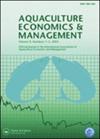Developing a bioeconomic framework for scallop culture optimization and product development
IF 3.7
2区 经济学
Q1 AGRICULTURAL ECONOMICS & POLICY
引用次数: 4
Abstract
Abstract Aquaculture is the fastest growing food production sector in the world and is quickly diversifying. In the Northwest Atlantic, interest in sea scallop (Placopecten magellanicus) (hereafter scallop) aquaculture has grown substantially. However, technical and economic challenges have hindered industry growth. We conducted bioeconomic simulations for various sized farms that targeted either live “whole” scallops or the shucked adductor muscle “meat.” The majority of farms selling whole scallops were profitable. However, all farms selling meats generated negative returns. Labor made up the greatest portion of costs in model simulations and increased linearly with farm size, representing a significant bottleneck. Whole scallop farm value was most sensitive to changes in (1) market price and (2) time to market. Our analysis suggests four strategies to increase farmed scallop production in the Northwest Atlantic: (1) mechanize low density net culture, (2) optimize net stocking densities, (3) build site selection tools, and (4) invest in consumer education, end-markets, and biotoxin testing for whole scallops. The sector will require a combination of regulatory, industry, and research cooperation to overcome these pressing challenges, but holds the potential to profitably diversify the bivalve aquaculture industry.开发扇贝养殖优化和产品开发的生物经济框架
水产养殖是世界上增长最快的粮食生产部门,并且正在迅速多样化。在西北大西洋,对海扇贝(Placopecten magellanicus)(以下简称扇贝)水产养殖的兴趣已大幅增长。然而,技术和经济挑战阻碍了行业的发展。我们对不同规模的养殖场进行了生物经济模拟,这些养殖场的目标要么是活的“整”扇贝,要么是脱壳后的内收肌“肉”。大多数出售整条扇贝的农场都是有利可图的。然而,所有出售肉类的农场都产生了负回报。在模型模拟中,劳动力占成本的最大部分,并且随着农场规模的增加呈线性增长,这是一个显著的瓶颈。整个扇贝农场价值对(1)市场价格和(2)上市时间的变化最为敏感。我们的分析提出了提高西北大西洋扇贝产量的四个策略:(1)机械化低密度净养殖;(2)优化净放养密度;(3)建立选址工具;(4)投资于消费者教育、终端市场和整个扇贝的生物毒素检测。该部门将需要监管、工业和研究合作相结合,以克服这些紧迫的挑战,但具有使双壳类水产养殖业多样化的盈利潜力。
本文章由计算机程序翻译,如有差异,请以英文原文为准。
求助全文
约1分钟内获得全文
求助全文
来源期刊

Aquaculture Economics & Management
FISHERIES-
CiteScore
7.30
自引率
17.90%
发文量
21
期刊介绍:
Aquaculture Economics and Management is a peer-reviewed, international journal which aims to encourage the application of economic analysis to the management, modeling, and planning of aquaculture in public and private sectors. The journal publishes original, high quality papers related to all aspects of aquaculture economics and management including aquaculture production and farm management, innovation and technology adoption, processing and distribution, marketing, consumer behavior and pricing, international trade, policy analysis, and the role of aquaculture in food security, livelihoods, and environmental management. Papers are peer reviewed and evaluated for their scientific merits and contributions.
 求助内容:
求助内容: 应助结果提醒方式:
应助结果提醒方式:


